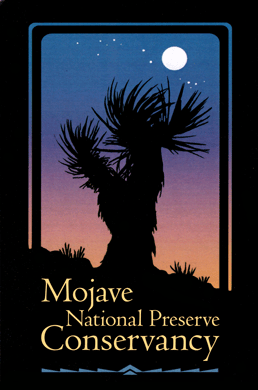The qualities of the Mojave National Preserve that draw us back time after time - wide open natural vistas, solitude, wildlife, and dark skies - can be lost or degraded if government representatives and policymakers do not know that we appreciate them. The Mojave National Preserve Conservancy continues to advocate for the responsible stewardship of our Mojave wildlands on multiple fronts. Here is where we stand:
Cadiz: Threat to Natural Springs
The Mojave National Preserve Conservancy recently joined a chorus of local citizens and conservation groups to oppose the Cadiz company's plans to sell desert groundwater to the Upper San Gabriel Valley Water District. (USGVWD) The USGWVD voted in mid-March to reject Cadiz's plans, but this threat is far from finished. Cadiz already has a contract with another water district in Orange County.
A bird perched on a Mojave yucca in the Preserve, with the Cadiz Valley in the distance.
The Cadiz company is planning a pipeline that would take 16.3 billion gallons of groundwater each year from the Mojave and sell it to the Santa Margarita Water District in Orange County. Cadiz's underhanded efforts to secure political support for its water export scheme are well documented. Cadiz would pump more water from the Mojave than could be recharged naturally through rainfall, based on a US Geological Survey report. This means that groundwater levels would fall, and natural springs that wildlife depend upon for survival would dry up.
Cadiz would pump groundwater from a basin that spans dozens of square miles, and underlies portions of the Preserve and the neighboring Mojave Trails National Monument. The groundwater basin feeds multiple natural springs - used by desert bighorn sheep, migrating and resident birds, native plants, and reptiles - that support an intricate ecosytem. And even a minor drop in groundwater levels can extinguish these springs and the wildlife that rely upon them.
Bonanza Spring south of the Preserve.
The Mojave National Preserve Conservancy supports Assembly Bill 1000, a proposal pending in the California state legislature that would increase scrutiny of the Cadiz project to ensure that it could not go forward until it is determined not to threaten our desert wildlands. If you are a California resident, contact your state legislator and ask them to oppose Cadiz's groundwater export scheme and support Assembly Bill 1000.
Desert Plan Revision: Opening lands to destructive industry
The Trump administration wants to revise the Desert Renewable Energy Conservation Plan (DRECP) to allow for more industrial-scale renewable energy and mining activities on public lands in the California desert. The Conservancy in March submitted comments to the Department of Interior opposing such revisions and advocating for the continued protection of desert wildlands and outdoor recreation opportunities in the California desert.
Large scale renewable energy and mining projects could ditsurb vast swaths of otherwise intact public lands, ruin wide open vistas, kill and displace wildlife, and tap precious groundwater resources. You may remember that the DRECP was finalized in 2016 and established protections for many of the wildlands around the Preserve, as well as some "development focus areas" for the renewable energy industry that the Department of Interior judged had low conflict with wildlife and outdoor recreation.
The Ivanpah Solar project adjacent to the Preserve destroyed over 5.6 square miles of intact desert wildlands and continues to kill avian species. Solar on rooftops and already-disturbed lands would be a more sustainable approach to generating clean energy.
The Trump administration's decision to re-open the plan and make changes favorable to big industry could significantly undermine the integrity of our desert landscapes and wildlife habitat. Interior is expected to roll out specific changes later this year, and that will present another opportunity for the Conservancy and its supporters to speak up. Stay tuned for our next steps.
Crescent Peak Wind Targets Joshua tree woodland
Sweden-based Eolus Wind is proposing a massive wind project on public lands in Nevada along the Preserve's northeastern border. The Crescent Peak Wind project would require the company to carve dozens of miles of wide roads into otherwise pristine Joshua tree woodland, and install as many as 220 turbines that would stand over 400 feet tall.
The Crescent Peak area of southern Nevada is part of one of the largest Joshua tree woodlands in the world.
In addition to destroying and industrializing one of the largest Joshua tree woodlands in the world, many of the 220 turbines will be visible from a large portion of the Mojave National Preserve, disrupting the sense of natural escape most visitors seek in this corner of the desert. Golden eagles and other raptors known to nest in the New York Mountains could be killed by the spinning turbine blades. Wind turbines also pose a particular threat to bats, according to scientific studies. The turbines may also drive away skittish desert bighorn sheep known to forage or migrate through the area.
The Bureau of Land Management (BLM) has begun review of the Crescent Peak Wind project and is accepting public input on issues and alternatives that should be included in an upcoming environmental assessment. The Conservancy has joined with other organizations to request that the BLM consider protecting the wildlands as an Area of Critical Environmental Concern (ACEC). The ACEC status would prohibit industrial development and allow for continued outdoor recreation access on these lands. You, too, can e-mail the BLM (blm_nv_sndo_crescentpeak@blm.gov) to request that they evaluate a conservation alternative that would reject the wind project and instead designate the lands as an ACEC.


